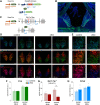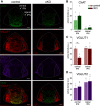Disruption of VGLUT1 in Cholinergic Medial Habenula Projections Increases Nicotine Self-Administration
- PMID: 34876472
- PMCID: PMC8751853
- DOI: 10.1523/ENEURO.0481-21.2021
Disruption of VGLUT1 in Cholinergic Medial Habenula Projections Increases Nicotine Self-Administration
Abstract
Cholinergic projections from the medial habenula (MHb) to the interpeduncular nucleus (IPN) have been studied for their complex contributions to nicotine addiction and have been implicated in nicotine reinforcement, aversion, and withdrawal. While it has been established that MHb cholinergic projections corelease glutamate, no direct evidence has demonstrated a role for this glutamate projection in nicotine consumption. In the present study, a novel floxed Slc17a7 [vesicular glutamate transporter 1 (VGLUT1)] mouse was generated and used to create conditional knock-out (cKO) mice that lack VGLUT1 in MHb cholinergic neurons. Loss of Slc17a7 expression in ventral MHb cholinergic neurons was validated using fluorescent in situ hybridization, and immunohistochemistry was used to demonstrate a corresponding reduction of VGLUT1 protein in cholinergic terminals in the IPN. We also used optogenetics-assisted electrophysiology to evoke EPSCs in IPN and observed a reduction of glutamatergic currents in the cKO, supporting the functional disruption of VGLUT1 in MHb to IPN synapses. cKO mice exhibited no gross phenotypic abnormalities and displayed normal thigmotaxis and locomotor behavior in the open-field assay. When trained to lever press for food, there was no difference between control and cKO. However, when tested in a nicotine self-administration procedure, we found that the loss of VGLUT1-mediated glutamate corelease led to increased responding for nicotine. These findings indicate that glutamate corelease from ventral MHb cholinergic neurons opposes nicotine self-administration, and provide additional support for targeting this synapse to develop potential treatments for nicotine addiction.
Keywords: acetylcholine; corelease; glutamate; interpeduncular nucleus; medial habenula; nicotine.
Copyright © 2022 Souter et al.
Figures





Similar articles
-
α3* Nicotinic Acetylcholine Receptors in the Habenula-Interpeduncular Nucleus Circuit Regulate Nicotine Intake.J Neurosci. 2021 Feb 24;41(8):1779-1787. doi: 10.1523/JNEUROSCI.0127-19.2020. Epub 2020 Dec 30. J Neurosci. 2021. PMID: 33380469 Free PMC article.
-
Chronic Nicotine Exposure Alters the Neurophysiology of Habenulo-Interpeduncular Circuitry.J Neurosci. 2019 May 29;39(22):4268-4281. doi: 10.1523/JNEUROSCI.2816-18.2019. Epub 2019 Mar 13. J Neurosci. 2019. PMID: 30867261 Free PMC article.
-
α3β4 nicotinic receptors in the medial habenula and substance P transmission in the interpeduncular nucleus modulate nicotine sensitization.Behav Brain Res. 2017 Jan 1;316:94-103. doi: 10.1016/j.bbr.2016.08.028. Epub 2016 Aug 13. Behav Brain Res. 2017. PMID: 27531501
-
The habenulo-interpeduncular pathway in nicotine aversion and withdrawal.Neuropharmacology. 2015 Sep;96(Pt B):213-22. doi: 10.1016/j.neuropharm.2014.11.019. Epub 2014 Dec 2. Neuropharmacology. 2015. PMID: 25476971 Free PMC article. Review.
-
Anxiety and Nicotine Dependence: Emerging Role of the Habenulo-Interpeduncular Axis.Trends Pharmacol Sci. 2017 Feb;38(2):169-180. doi: 10.1016/j.tips.2016.11.001. Epub 2016 Nov 24. Trends Pharmacol Sci. 2017. PMID: 27890353 Free PMC article. Review.
Cited by
-
A quantitative analysis of bestrophin 1 cellular localization in mouse cerebral cortex.Acta Physiol (Oxf). 2025 Jan;241(1):e14245. doi: 10.1111/apha.14245. Epub 2024 Oct 28. Acta Physiol (Oxf). 2025. PMID: 39466647 Free PMC article.
-
Nicotine addiction: More than just dopamine.Curr Opin Neurobiol. 2023 Dec;83:102797. doi: 10.1016/j.conb.2023.102797. Epub 2023 Oct 11. Curr Opin Neurobiol. 2023. PMID: 37832393 Free PMC article. Review.
-
STZ-induced hyperglycemia differentially influences mitochondrial distribution and morphology in the habenulointerpeduncular circuit.Front Cell Neurosci. 2024 Dec 23;18:1432887. doi: 10.3389/fncel.2024.1432887. eCollection 2024. Front Cell Neurosci. 2024. PMID: 39763617 Free PMC article.
-
Habenula bibliometrics: Thematic development and research fronts of a resurgent field.Front Integr Neurosci. 2022 Aug 3;16:949162. doi: 10.3389/fnint.2022.949162. eCollection 2022. Front Integr Neurosci. 2022. PMID: 35990593 Free PMC article.
-
Nanoscopic distribution of VAChT and VGLUT3 in striatal cholinergic varicosities suggests colocalization and segregation of the two transporters in synaptic vesicles.Front Mol Neurosci. 2022 Sep 13;15:991732. doi: 10.3389/fnmol.2022.991732. eCollection 2022. Front Mol Neurosci. 2022. PMID: 36176961 Free PMC article.
References
-
- Akers AT, Cooper SY, Baumgard ZJ, Casinelli GP, Avelar AJ, Henderson BJ (2020) Upregulation of nAChRs and changes in excitability on VTA dopamine and GABA neurons correlates to changes in nicotine-reward-related behavior. eNeuro 7:ENEURO.0189-20.2020–0120. 10.1523/ENEURO.0189-20.2020 - DOI - PMC - PubMed
-
- Antolin-Fontes B, Li K, Ables JL, Riad MH, Görlich A, Williams M, Wang C, Lipford SM, Dao M, Liu J, Molina H, Heintz N, Kenny PJ, Ibañez-Tallon I (2020) The habenular G-protein–coupled receptor 151 regulates synaptic plasticity and nicotine intake. Proc Natl Acad Sci USA 117:5502–5509. 10.1073/pnas.1916132117 - DOI - PMC - PubMed
Publication types
MeSH terms
Substances
Grants and funding
LinkOut - more resources
Full Text Sources
Molecular Biology Databases
Research Materials
